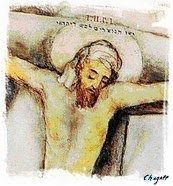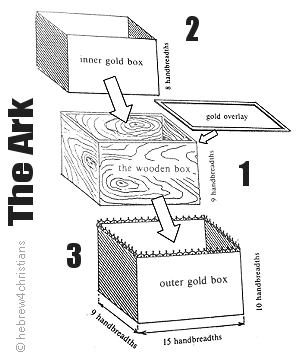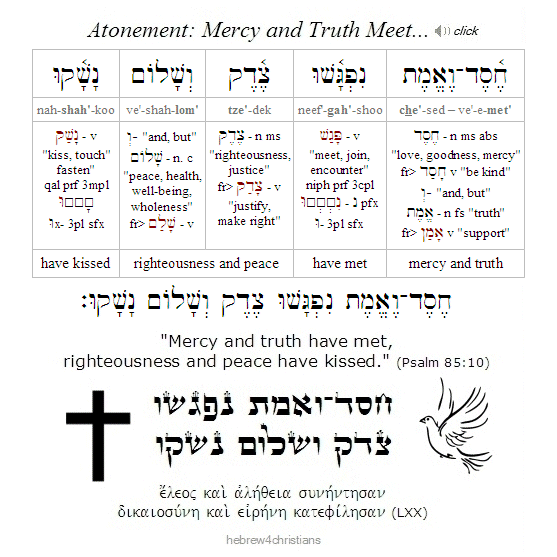|
|
|||||||||||||||||||||
 |
|||||||||||||||||||||
|
Learn Hebrew |
|||||||||||||||||||||
|
|
||||||||||||||||||||||||||||
|
The earthy Tabernacle (i.e., Mishkan) and its furnishings were "copies" of the heavenly Temple and the Throne of God Himself. Moses was commanded to make the Sanctuary according to the "pattern" revealed at Sinai (Exod. 25:9). As it is written in our Scriptures, "For Messiah has entered, not into holy places made with hands, which are representations (ß╝Ć╬ĮŽäßĮĘŽäŽģŽĆ╬┐Žé) of the true things, but into heaven itself, now to appear in the presence of God on our behalf" (Heb. 9:24). The centermost point of the earthly Tabernacle was the Ark of the Covenant (ūÉų▓ū©ūĢų╣ū¤ųŠūöųĘū¦ų╝ūōųČū®ūü), a "three-in-one" box that contained God's Holy Word (i.e., the tablets of the Torah). As such, the Ark served as a symbol of kisei ha-kavod (ūøų╝ų┤ūĪų╝ųĄūÉ ūöųĘūøų╝ųĖūæūĢų╣ūō), the Throne of Glory. The Ark stood entirely apart as the only furnishing placed in the "three-in-one" space called the Holy of Holies (ū¦ūōųČū®ūü ūöųĘū¦ų╝ų│ūōųĖū®ūüų┤ūÖūØ). Upon the cover of the Ark (i.e., the kapporet) were fashioned two cherubim (i.e., angel-like figures) that faced one another (Exod. 25:17-18). According to the Talmud (Succah 5b), each cherub had the face of a child - one boy and one girl - and their wings spread heavenward as their eyes gazed upon the cover (Exod. 25:20). This was the sacred place where the blood of purification was sprinkled during Yom Kippur, the Day of Atonement, and this is the Place (ūöųĘū×ų╝ųĖū¦ūĢų╣ūØ) that prefigured the offering of the blood of the Messiah, our eternal Mediator of the New Covenant. "For I will appear in the cloud over the kapporet" (Lev. 16:2; Exod. 25:22). As it is written, "I have blotted out your transgressions like a thick cloud and your sins like heavy mist; return to me (ū®ūüūĢų╝ūæųĖūö ūÉųĄū£ųĘūÖ), for I have redeemed you (Isa. 44:22).
The central ritual of atonement given in the Torah is that of the anointed High Priest sprinkling sacrificial blood over the tablets of the law upon the kapporet (the "mercy seat") of the Ark of the Covenant - the Place where "Love and truth meet, where righteousness and peace kiss" (Psalm 85:10). It was from the midst of the surrounding cloud in the Holy of Holies that the Voice of the LORD was heard, just as it was in the midst of the surrounding cloud of darkness upon the cross that Yeshua cried out in intercession for our sins... ūŚūĪūōųŠūĢūÉū×ū¬ ūĀūżūÆū®ūüūĢ che'┬Ęsed ve┬Ęe┬Ęmet neef┬Ęgah'┬Ęshoo "Mercy and truth have met,
|
|
Hebrew for Christians |
|||||
|
|||||



